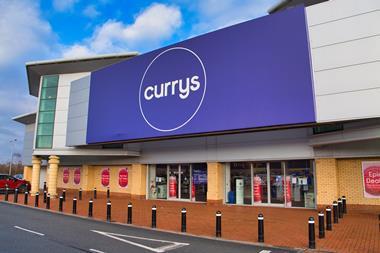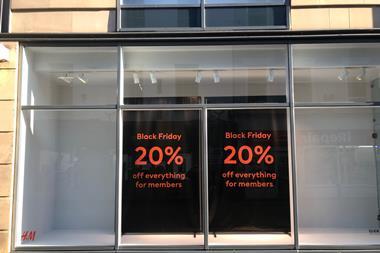It seems intuitive that the longer consumers spend in a shopping centre, the more they will spend. But it has taken tracking shoppers via their mobile phone signals and a research study, undertaken in association with the world-famous Massachusetts Institute of Technology (MIT), to prove the point.
After nine months of gathering data on shopping dwell time and analysing it against sales in all the stores at a UK shopping centre, the results showed that for every 1 per cent increase in the average amount of time spent shopping, sales increased 1.3 per cent across the centre.
This insight couldn’t come at a better time for retailers, coinciding with the news from Experian that visits to out-of-town retail destinations fell 3.1 per cent in the year to September compared with the same period the previous year.
While overall retail footfall has risen 0.5 per cent during the same period, the CBI says that the UK high street is experiencing declining sales and it only expects more of the same with its October figures.
UK technology start-up Path Intelligence, which developed the system that was used to track the mobile phone signals, undertook the research. It is now rolling out the system for four UK shopping centre operators, as well as talking directly to retailers about what the analysis that is possible with the system could do for them.
Land Securities has been running the system for more than a year at its Gunwharf Quays scheme in Portsmouth. It has been used to complement existing people-counting technology from Experian FootFall.
In addition to measuring dwell time, Path Intelligence’s system can identify the percentage of visitors entering different stores within the scheme and allow the centre’s managers to work more closely with retailers to maximise their sales potential.
Land Securities retail operations director Mike Davidson says that the continuous nature of the data it receives from the system, tied in with its existing exit poll data, is proving advantageous.
Path Intelligence chief operating officer Sharon Biggar says that until now it has not always been clear whether consumers come into a centre, spend money and then hang around, or whether there is an opportunity to sell more to them. She says: “Some centres have encouraged customer churn, while others have tried to turn their centre into a destination.”
She explains that tracking consumers by their mobile phone works well, because 94 per cent of shoppers carry a mobile phone with them that is turned on and so is a good indicator of shopping behaviour.
The system detects transmissions between mobile phones and mobile networks via the TMSI number that each phone is given when it connects to a mobile network. Consumers cannot be identified via this number and Path Intelligence is clear that consumers should have no concerns about how the data collected is used. Biggar likens this to the way that internet users can be tracked via an IP address without it being revealed who they are.
The technology that allows mobile signals to be detected was developed at MIT and is software-based, rather than relying on expensive hardware. The antennae used send the information they receive over a 3G mobile phone connection each night, which means that they can be moved around easily and temporary antennae also easily erected. They can be situated near each other, to measure traffic through zones in a department store for instance, or spread out to track traffic through a town centre.
Path Intelligence clients receive a weekly e-mail with the highlights of what has happened. They also have access to a portal with data that can be downloaded to Excel for their own use. Biggar says: “We can put it in for a week or a year – it really depends on the questions you are asking – but we would tend to put it in and leave it for a year because retail is so seasonal.”
She adds that retailers and shopping centre owners that deploy the system often have a set question, but find that the results they get generate a host of further queries.
At Gunwharf Quays, for example, management wanted to understand shoppers’ relationship both with its anchor tenant Marks & Spencer and with its Spinnaker Tower attraction, as well as to identify numbers of people who walk through the site without visiting any stores. The analysis so far has shown that 80 per cent of visitors to the Spinnaker Tower also spend time in the scheme’s stores.
Biggar says that the system has also proved useful for monitoring the success of events within shopping centres. For instance, it proved that a recent beach volleyball event at a centre drove shoppers into sports stores nearby.
Land Securities is keen to use the information that the tracking technology can deliver on the mix of stores that customers visit. Davidson says that this insight into brand allegiance could back up or disprove the research that retailers do themselves into which other retail brands best complement their own. Biggar explains: “We can group stores together to see if customers who for instance go into Gap also visit Starbucks.”
She adds that retailers tend to make decisions on where to site new stores, especially within shopping centres, based on footfall. However, the analysis that the system provides means that they can refine what they look for in a centre. “The key thing that they would want to look at is how many people come to the centre and only go to the anchor site. The expensive sites have tended to be next to the anchor tenant. We can create heat maps that should impact on rents,” she says.
The nine-month study highlighted other interesting trends. For example, Biggar notes: “The second key result is that when a centre is busy shoppers behave differently; although one other hypothesis is that those who come to a mall when it is busy are a different type of shopper.”
Dwell time is highest early in the week – between Monday and Wednesday – and falls to its lowest levels at the weekend and in particular on Saturdays. Dwell time also falls during the school holidays. Biggar says that this finding, combined with the link between dwell time and sales, make it clear that when a shopping centre is not busy, the centre’s manager – and its tenants – should focus on getting people to stay longer. However, adding to congestion on the busiest days may not be helpful in increasing overall sales.
So the report has suggested that the most appropriate time to encourage customers to linger is during the early part of the week – when centres are less congested – and that parking prices or cross-store promotions could be used to encourage this.
Another finding was that – as most retailers would probably expect – average dwell time decreases as the number of empty retail units increases. Again, while this intuitively makes sense, it can prove to centre operators the lost opportunities in letting units sit empty.
Path Intelligence has formally partnered with Experian FootFall, whose technology already has a presence in many shopping centres. Experian FootFall director of strategy and product management Mike Roberts says that the extra insight that the Path Intelligence system will bring makes it much more valuable to centre operators and retailers that need to base decisions on it. He explains: “Just counting people is all well and good, but in these times it needs to be usable.”
He adds that the Path Intelligence system will take the information that Experian is able to provide to a higher level and removes the need to have counters in place to capture zone and tenant count information.
Roberts says that the two companies have been visiting centre operators and retailers together over the past year, even though they have only just formalised their relationship, and have not come across any company that has said that it would have no use for the information the partnership can provide.
Biggar concludes that once the system has answered the bigger questions and centre operators can understand footfall to each individual retailer the ideal is to use it operationally. She says: “It allows operators to be proactive about improving the centre, rather than waiting for the retailers to come to them.”
At a time when retailers need to sweat their property assets, any extra information that can help them to bring shoppers into stores has to be a good thing.


























No comments yet